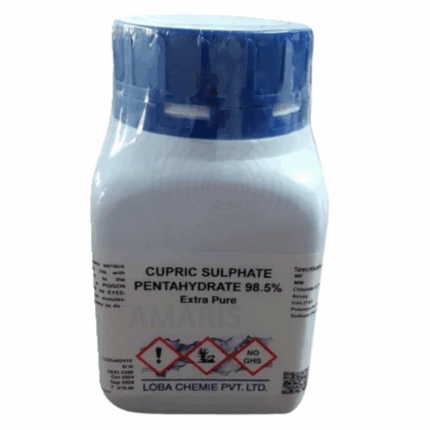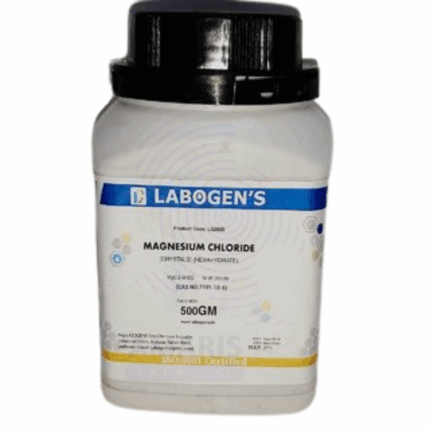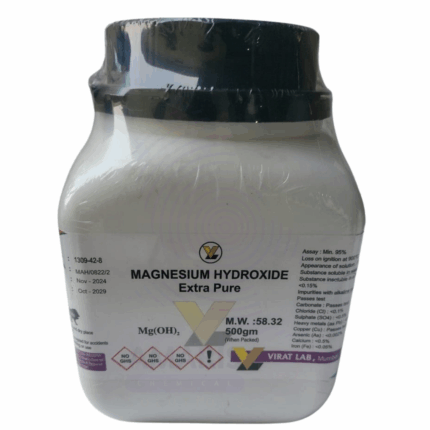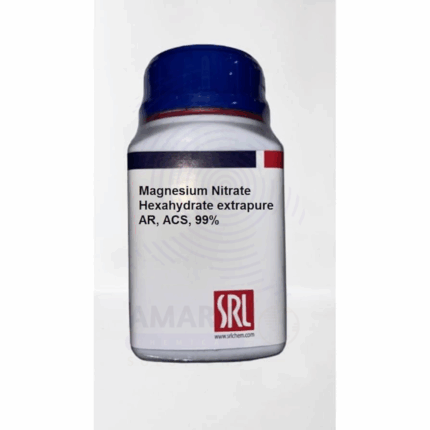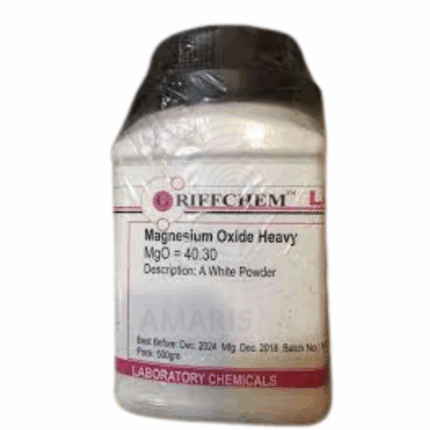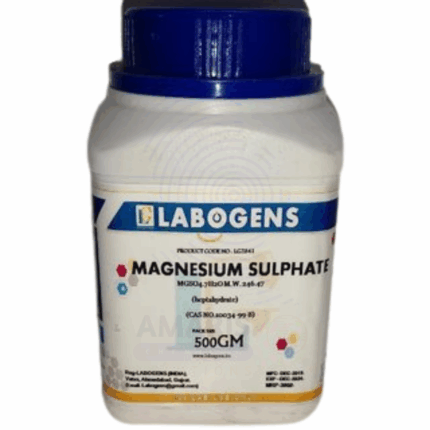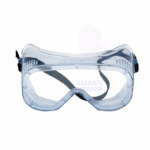

Victoria blue Extra Pure
$ 18.78 Original price was: $ 18.78.$ 18.65Current price is: $ 18.65.
Victoria Blue Extra Pure is a high-purity, deep blue synthetic dye primarily used as a biological stain and textile dye. It exhibits strong affinity for acidic cellular components and is widely employed in microscopy, histology, and microbiology for staining applications. It dissolves readily in water and organic solvents, producing intense coloration with good stability. The Extra Pure grade ensures minimal impurities, making it suitable for analytical and research purposes. Handling requires standard chemical safety precautions due to its irritant potential. Storage in cool, dry, and protected conditions maintains product integrity.
Victoria blue Extra Pure
PRIMARY USES
- Analytical Reagent & Laboratory Applications:
- Used extensively as a biological stain in microscopy, histology, and cytology for visualizing acidic cellular components such as nuclei and cartilage
- Functions as a cationic basic dye binding to anionic cell structures, providing contrast in tissue and bacterial staining
- Employed in colorimetric and spectrophotometric assays as an indicator dye due to strong absorbance
- Used in microbiological staining such as Gram staining and vital staining to differentiate microbial species
- Applied in biochemical and molecular biology research for nucleic acid and protein visualization
- Glass & Ceramics Manufacturing:
- Not typically used
- Pharmaceutical & Cosmetic Industry:
- Used as a staining dye in pharmaceutical research and diagnostics
- Occasionally utilized in cosmetic products as a regulated colorant
SECONDARY USES
- Textile & Dyeing Industry:
- Widely applied as a dye for protein fibers (wool, silk) and synthetic fibers (nylon)
- Produces bright, vivid blue shades with moderate to good light and wash fastness
- Used in fabric dyeing processes requiring strong basic dyes
- Microbiology & Medical Diagnostics:
- Employed as a vital stain in laboratory diagnostics to detect bacteria and cell morphology
- Used in specialized staining protocols such as Loeffler’s methylene blue alternative
| PACK SIZE |
100 grams Plastic Tin |
|---|
1. Basic Identification Attributes
- Chemical Name: Victoria Blue BO Extra Pure
- CAS Number: 632-99-5
- HS Code: 3204.17.00
- Molecular Formula: C₄₀H₄₄ClN₃S
- Synonyms:
-
- Victoria Blue B
- Basic Blue 11
- Victoria Blue BO
2. Physical & Chemical Properties
- Physical State: Solid (powder or crystalline)
- Color & Odor: Deep blue, odorless
- Melting Point: Decomposes before melting
- Density/Specific Gravity: Not widely reported
- Solubility:
-
- Soluble in water (deep blue solution)
- Soluble in ethanol and many organic solvents
- pH Level: Neutral to slightly basic in aqueous solution
- Vapor Pressure & Volatility: Negligible
- Flash Point: Not applicable
- Autoignition Temperature: Not applicable
- Viscosity: Not applicable
3. Safety & Hazard Attributes
- Hazard Class (GHS Classification):
-
- Skin irritation (Category 2)
- Eye irritation (Category 2A)
- Possible sensitizer on prolonged exposure
- NFPA Ratings:
-
- Health: 2
- Flammability: 0
- Reactivity: 0
- Exposure Limits: No specific OSHA PEL or ACGIH TLV established
- Reactivity: Stable under normal conditions
4. Storage & Handling Attributes
- Storage Conditions:
- Store in a cool, dry, well-ventilated area
- Protect from light and moisture
- Incompatible Materials:
- Strong oxidizing agents
- Strong acids and bases
- Container Type:
- Sealed polyethylene or glass containers
- Shelf Life & Expiration Date: Stable for several years if stored properly
- Special Handling Requirements:
- Use gloves and safety goggles
- Avoid inhalation of dust
- Minimize skin and eye contact
5. Regulatory & Compliance Attributes
- Regulatory Status:
- Approved for laboratory and industrial use
- Not approved as a food additive or pharmaceutical excipient
6. Environmental & Health Impact
- Ecotoxicity: Low toxicity to aquatic life
- Persistence in Environment: Moderately persistent under environmental conditions
- Carcinogenicity/Mutagenicity: Not classified as carcinogenic or mutagenic
- Biodegradability: Poorly biodegradable due to synthetic aromatic structure
SAFETY PRECAUTIONS
Personal Protective Equipment (PPE):
- Wear chemical-resistant gloves (e.g., nitrile or butyl rubber)
- Use safety goggles or face shield to prevent eye contact
- Wear a lab coat or protective clothing
- If dust is generated, use a suitable dust mask or respirator
Handling:
- Handle in a well-ventilated area
- Avoid contact with skin, eyes, and clothing
- Do not breathe dust
- Wash hands thoroughly after handling
Storage:
- Store in a tightly sealed container
- Keep in a dry, cool, well-ventilated place
- Protect from moisture, light, and incompatible materials such as oxidizers
FIRST AID MEASURES
Inhalation:
- Move to fresh air immediately
- Seek medical attention if breathing becomes difficult
Skin Contact:
- Wash thoroughly with soap and water
- Remove contaminated clothing
- Seek medical advice if irritation occurs
Eye Contact:
- Rinse immediately with plenty of water for at least 15 minutes
- Keep eyelids open during rinsing
- Seek medical attention promptly
Ingestion:
- Rinse mouth with water
- Do not induce vomiting unless advised by medical personnel
- Seek medical attention if symptoms appear
FIRE FIGHTING MEASURES
Flammability:
- Non-flammable solid
Extinguishing Media:
- Use dry chemical, CO₂, foam, or water spray
Hazardous Combustion Products:
- When heated, may release toxic fumes including nitrogen oxides and sulfur oxides
Firefighter Protection:
- Wear self-contained breathing apparatus (SCBA) and full protective gear
- Avoid inhaling thermal decomposition products


 Preservatives(food)
Preservatives(food) Flavor Enhancers
Flavor Enhancers Acidulants
Acidulants Sweeteners
Sweeteners Antioxidants
Antioxidants Colorants(food)
Colorants(food) Nutraceutical Ingredients (food)
Nutraceutical Ingredients (food) Nutrient Supplements
Nutrient Supplements Emulsifiers
Emulsifiers
 Collectors
Collectors Dust Suppressants
Dust Suppressants Explosives and Blasting Agents
Explosives and Blasting Agents Flocculants and Coagulants
Flocculants and Coagulants Frothers
Frothers Leaching Agents
Leaching Agents pH Modifiers
pH Modifiers Precious Metal Extraction Agents
Precious Metal Extraction Agents
 Antioxidants(plastic)
Antioxidants(plastic) Colorants (Pigments, Dyes)
Colorants (Pigments, Dyes) Fillers and Reinforcements
Fillers and Reinforcements Flame Retardants
Flame Retardants Monomers
Monomers Plasticizers
Plasticizers Polymerization Initiators
Polymerization Initiators Stabilizers (UV, Heat)
Stabilizers (UV, Heat)
 Antifoaming Agents
Antifoaming Agents Chelating Agents
Chelating Agents Coagulants and Flocculants
Coagulants and Flocculants Corrosion Inhibitors
Corrosion Inhibitors Disinfectants and Biocides
Disinfectants and Biocides Oxidizing Agents
Oxidizing Agents pH Adjusters
pH Adjusters Scale Inhibitors( water)
Scale Inhibitors( water)
 Antioxidants(cosmetic)
Antioxidants(cosmetic) Emollients
Emollients Fragrances and Essential Oils
Fragrances and Essential Oils Humectants
Humectants Preservatives
Preservatives Surfactants(cosmetic)
Surfactants(cosmetic) Thickeners
Thickeners UV Filters
UV Filters
 Fertilizers
Fertilizers Soil Conditioners
Soil Conditioners Plant Growth Regulators
Plant Growth Regulators Animal Feed Additives
Animal Feed Additives Biostimulants
Biostimulants Pesticides (Herbicides, Insecticides, Fungicides)
Pesticides (Herbicides, Insecticides, Fungicides)
 Active Pharmaceutical Ingredients (APIs)
Active Pharmaceutical Ingredients (APIs) Excipients
Excipients Solvents(pharmaceutical)
Solvents(pharmaceutical) Antibiotics
Antibiotics Antiseptics and Disinfectants
Antiseptics and Disinfectants Vaccine Adjuvants
Vaccine Adjuvants Nutraceutical Ingredients (pharmaceutical)
Nutraceutical Ingredients (pharmaceutical) Analgesics & Antipyretics
Analgesics & Antipyretics
 Analytical Reagents
Analytical Reagents Solvents(lab)
Solvents(lab) Chromatography Chemicals
Chromatography Chemicals Spectroscopy Reagents
Spectroscopy Reagents microbiology-and-cell-culture-reagents
microbiology-and-cell-culture-reagents Molecular Biology Reagents
Molecular Biology Reagents Biochemical Reagents
Biochemical Reagents Inorganic and Organic Standards
Inorganic and Organic Standards Laboratory Safety Chemicals
Laboratory Safety Chemicals Specialty Laboratory Chemicals(Special Laboratory Equipment)
Specialty Laboratory Chemicals(Special Laboratory Equipment)
 Demulsifiers
Demulsifiers Hydraulic Fracturing Fluids
Hydraulic Fracturing Fluids Scale Inhibitors(oil)
Scale Inhibitors(oil) Surfactants(oil)
Surfactants(oil) Drilling Fluids
Drilling Fluids
 Dyes and Pigments
Dyes and Pigments Bleaching Agents
Bleaching Agents Softening Agents
Softening Agents Finishing Agents
Finishing Agents Antistatic Agents
Antistatic Agents
 Admixtures
Admixtures Waterproofing Agents
Waterproofing Agents Sealants and Adhesives
Sealants and Adhesives Curing Compounds
Curing Compounds Concrete Repair Chemicals
Concrete Repair Chemicals Anti-Corrosion Coatings
Anti-Corrosion Coatings
 Surfactants(cleaning)
Surfactants(cleaning) Builders
Builders Enzymes
Enzymes Solvents (Cleaning)
Solvents (Cleaning) Fragrances
Fragrances
 Electronic Chemicals
Electronic Chemicals Catalysts
Catalysts Lubricants
Lubricants Photographic Chemicals
Photographic Chemicals Refrigerants
Refrigerants Automotive chemicals
Automotive chemicals Pyrotechnic Chemicals
Pyrotechnic Chemicals
 Biodegradable Surfactants
Biodegradable Surfactants Bio-based Solvents
Bio-based Solvents Renewable Polymers
Renewable Polymers Carbon Capture Chemicals
Carbon Capture Chemicals Wastewater Treatment Chemicals
Wastewater Treatment Chemicals
 Pigments
Pigments Solvents(paint)
Solvents(paint) Specialty Coatings
Specialty Coatings Binders/Resins
Binders/Resins Additives
Additives Driers
Driers Anti-Corrosion Agents
Anti-Corrosion Agents Functional Coatings
Functional Coatings Application-Specific Coatings
Application-Specific Coatings
 Fresh Herbs
Fresh Herbs Ground Spices
Ground Spices Whole Spices
Whole Spices Spice Blends
Spice Blends Dried Herbs
Dried Herbs
 Leavening Agents
Leavening Agents Dough Conditioners
Dough Conditioners Flour Treatments
Flour Treatments Fat Replacers
Fat Replacers Decoratives
Decoratives Preservatives(baking)
Preservatives(baking)
 Plasticizers & Softeners
Plasticizers & Softeners Reinforcing Agents
Reinforcing Agents Adhesion Promoters
Adhesion Promoters Vulcanizing Agents
Vulcanizing Agents Antidegradants
Antidegradants Blowing Agents
Blowing Agents Fillers & Extenders
Fillers & Extenders Accelerators & Retarders
Accelerators & Retarders


